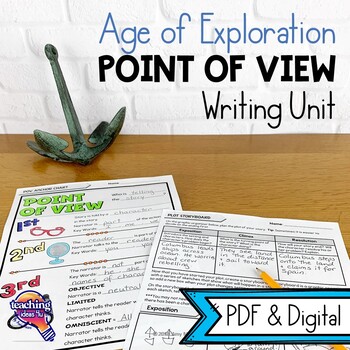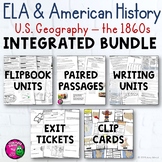Age of Exploration Narrative Writing Unit: Point of View & Historical Fiction
- Zip
- Google Apps™

Also included in
- Exploration and Language Arts Resource Bundle SetThis integrated bundle has everything you need to teach the Age of Exploration and language arts skills at the same time! The bundle includes 5 separate resources that include a nonfiction/informational texts unit on exploration and explorers, a pairePrice $25.80Original Price $32.25Save $6.45
- American History Writing Units Bundle: U.S. Geography - Westward ExpansionAre you looking for a way to integrate writing standards into your American history class? This bundle includes 7 different writing projects that cover U.S. regions, Native Americans, Exploration, Colonial America, American RePrice $39.40Original Price $49.25Save $9.85
- Are you struggling to cover all your standards due to a lack of time? Save your time and energy with this ELA and American History Integrated Bundle. These resources combine language arts and social studies standards for you to use in your 4th, 5th, & 6th grade classrooms. These integrated unitsPrice $165.00Original Price $226.25Save $61.25
Description
Age of Exploration Writing Unit: Writing Historical Fiction in 1st Person Point of View (PDF & Google Slides)
Students read two mentor texts that contain two different points of view on the encounter between Christopher Columbus and the Taino people. After discussing how point of view affects how the story is told, students begin researching an explorer and a tribe he encountered in the Americas. Students then plan and write two short historical fiction stories: one from the explorer's point of view and one from a Native person's point of view.
The unit can be used as a summative assessment for Exploration, as well as a narrative writing piece.
This unit integrates studying about the Age of Exploration into a lesson on point of view and narrative writing. This resource includes mini-lessons that teachers can use or skip, depending upon the needs of their class.
This is a complete unit that includes everything but the suggested mentor text. (Two texts are recommended and teachers can find them at the library.) The unit comes in both PDF and Google Slides formats.
UNIT OVERVIEW
Students begin the unit with a lesson on point of view. They learn about 1st, 2nd, and 3rd person point of view, then complete an anchor chart.
Before reading mentor texts, students respond to two prewriting topics that prepares them to understand how point of view affects how an event is seen by different people. The class reads two different mentor texts and discusses both their points of view and how the encounter is portrayed.
Students then read the project direction page and selects (or is assigned) an explorer and a Native people to research. They use the research sheets to help organize their background information, then they use a storyboard to plan their short stories.
An optional worksheet on writing a Bibliography is included in a case teacher's require one.
Other resources are included: student project checklist, social studies rubric, and narrative writing rubric.
UNIT CONTENTS
Everything needed to publish a final letter is included - just print and go! This resource includes:
- Suggested Lesson Plan, including suggested mentor texts
- Suggested Standards Covered
- Anchor Chart (printable pieces) for Point of View (1st, 2nd, & 3rd)
- Student Anchor Chart Page for Point of View
- Questions for the mentor texts
- 2 Prewriting Prompts
- Project Direction Page
- Explorer Sign Up Sheet
- Notes pages for the explorer and the Native people
- Bibliography Worksheet (optional)
- Storyboard organizers
- Student Final Project Checklist
- Narrative Rubric
- Social Studies Rubric
The length this lesson takes will depend upon how long students take to research their people, plan, and write their stories. I estimate 2 - 3 weeks of 30 minutes sessions. Teachers should adapt this project as needed to fit their grade level and student ability-levels.
*****************************************************************************
Customer Tips:
How to get TPT credit to use on future purchases:
• Please go to your My Purchases page (you may need to login). Beside each purchase you'll see a Provide Feedback button. Simply click it and you will be taken to a page where you can give a quick rating and leave a short comment for the product. Each time you give feedback, TPT gives you feedback credits that you use to lower the cost of your future purchases. I value your feedback greatly as it helps me determine which products are most valuable for your classroom so I can create more for you. ☺
Be the first to know about my new discounts, freebies and product launches:
• Look for the green star next to my store logo and click it to become a follower. Voila! You will now receive email updates about this store. ☺
************************************************************************************








